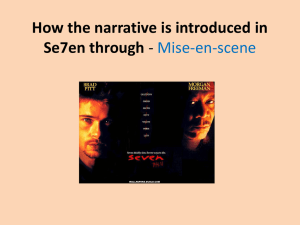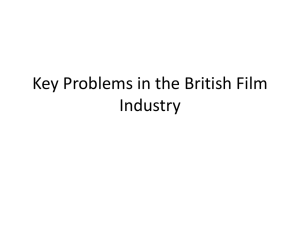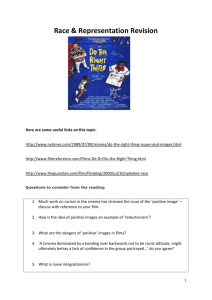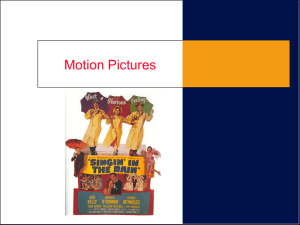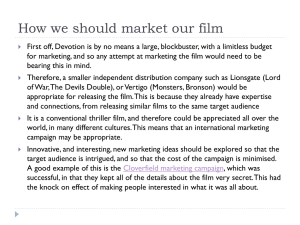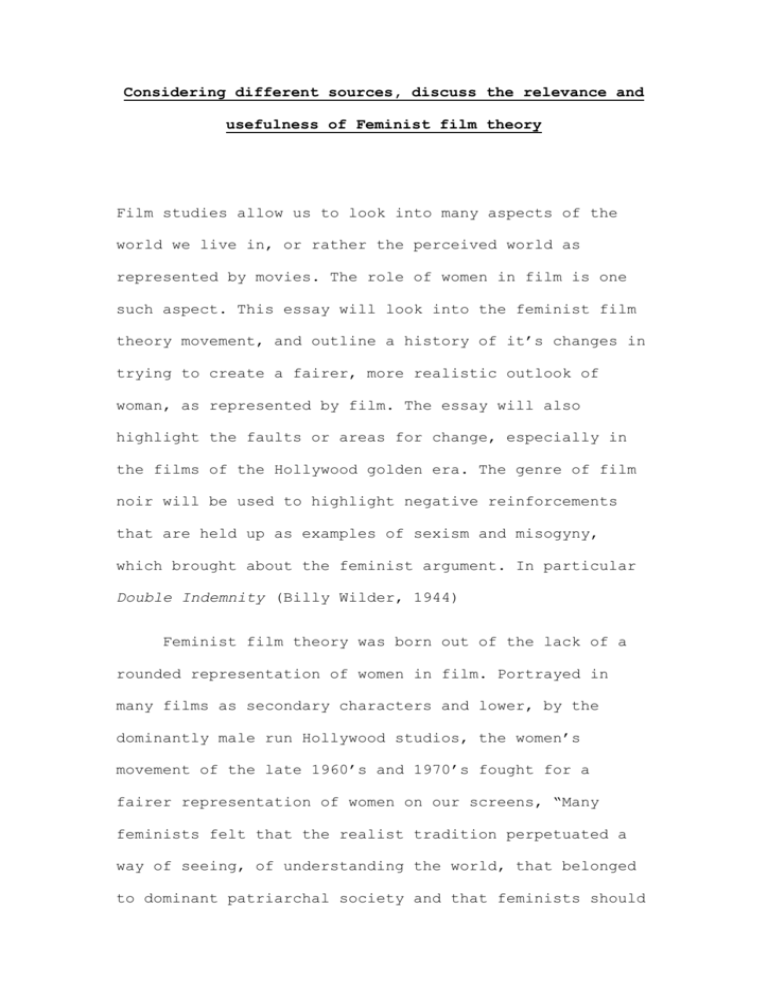
Considering different sources, discuss the relevance and
usefulness of Feminist film theory
Film studies allow us to look into many aspects of the
world we live in, or rather the perceived world as
represented by movies. The role of women in film is one
such aspect. This essay will look into the feminist film
theory movement, and outline a history of it’s changes in
trying to create a fairer, more realistic outlook of
woman, as represented by film. The essay will also
highlight the faults or areas for change, especially in
the films of the Hollywood golden era. The genre of film
noir will be used to highlight negative reinforcements
that are held up as examples of sexism and misogyny,
which brought about the feminist argument. In particular
Double Indemnity (Billy Wilder, 1944)
Feminist film theory was born out of the lack of a
rounded representation of women in film. Portrayed in
many films as secondary characters and lower, by the
dominantly male run Hollywood studios, the women’s
movement of the late 1960’s and 1970’s fought for a
fairer representation of women on our screens, “Many
feminists felt that the realist tradition perpetuated a
way of seeing, of understanding the world, that belonged
to dominant patriarchal society and that feminists should
break with this tradition.” (Nelmes, 1999.pp.278) Thus
feminist film theory is born, and like many theories the
feminist theory is multi faceted and ever changing, and
has been since its inception into the film studies world.
Feminist film theory can be broken down into three
main areas. Starting with Molly Haskell and Marjorie
Rossen’s Reflection Theory; Claire Johnston’s Ideological
Critique to Laura Mulvey’s use of psychoanalysis. All
three theories are asking for different things in
relation to how women are portrayed on screen.
Reflection theory points at the overall view that
cinema has a detrimental effect on how women are viewed
in the ‘real’ world, “they assume that film ‘reflects’
social reality, that depictions of women in film mirror
how society treats women.” (White, 1998,pp.118)
Reflective theory also argues the role of women as that
of stereotype as reflection, “Such studies present and
critique a typology of images of women. An array of
virgins, vamps, victims, suffering mothers, child woman
and sex kitten.” (White, 1998.pp.118) That these
stereotypes are the only ideal of women as shown through
the masculine world of cinema was a wrongdoing, and
infact as bad as the racial and sexual female stereotypes
that existed in the films of this era, “the homicidal,
man hating lesbian, the African American mammy, the
tragic mulatto and the Asian dragon lady.” (White,
1998.pp.118)
The ideological critique championed by Claire
Johnston was to focus on semiotics, especially the work
of Roland Barthes and the ideology behind women’s roles
in cinema. This critique used auteur theory and genre
study to delve deeper into texts of films rather than the
‘image’ that reflection theory had offered, “film must be
seen as a language and woman as a sign - not simply a
transparent reading of the real.” (White, 1998.pp.118)
This use of ideology and semiotics allowed for further
discussion, into new areas including genres and subgenres, “This showed how woman as a signifier performed
precise iconographic and ideological functions,
constituting a genres structural dimensions, (woman =
home in the western.” (White, 1998.pp.119) Johnston
argued that mainstream film should and could be used to
show these fuller more rounded portrayals of women in
film, “Ideas derived from the entertainment film, then,
should inform the political film, and political ideas
should inform the entertainment cinema: a two way
process.” (Johnston, 1976.pp.217)
All this was countered
in the next area of feminist theory by Laura Mulvey’s use
of Freudian psychoanalysis and the statement that
feminist film should break away from the mainstream
(entertainment) film and form it’s own oppositional
cinema, made by women for women.
Psychoanalysis was born around the same time as
cinema at the end of the nineteenth century, and for
feminist theory went hand in hand, “Sigmund Freud, who is
generally accepted as the founding father of
psychoanalysis, may have offered a revolutionary
perspective on human behaviour and motivation but it was
a perspective that was male-orientated, male led and in
every sense phallocentric.” (Bennett, Hickman et al,
2007,pp.253) This is where Mulvey’s theories are etched,
in the psychoanalytical male domination of cinema. The
patriarchal system created movies for men, made by men
that subjected and objectified women. Mulvey coined the
term ‘the male gaze’ that established the camera,
director, spectator as in control of what, and how we
look at images especially women. She used Freud’s term of
‘scopophilia’ or the pleasure of looking, to establish
her point, along with the use of narcissism to reinforce
the male ego, in her work ‘Visual Pleasure and Narrative
Cinema’.
Mulvey argued that the whole system of making films
was irresponsible because of this. That all male made
films adhered to a certain ideological code that was
detrimental in its representation of women, “all
narratives appeared to exhibit an Oedipal trajectory;
that is, the (male) hero was given a crisis in which he
had to assert himself over a man (often a father figure)
in order to achieve recognition and win the woman. In
this way, film is seen to represent the workings of
patriarchal ideology.” (Bennett, Hickman et al,
2007,pp.254)
Classical Film Noir adheres to the rules as stated
by the feminist theorists. It has many representations of
women in a world created by men. This is an exaggerated
image of women in film, a female image that could be
fetishised, which produced the ultimate female, and new
icon, the femme fatale. Lana Turner in The Postman Always
Rings Twice, (Tay Garnett, 1946) Lauren Bacall in The Big
Sleep (Howard Hawks, 1946) and Barbara Stanwyk in Double
Indemnity. All were fetishised stereotypes; the bored
housewife, the spoilt heiress and the gold-digger. All
were objects of voyeurism and a great indication of the
gender differences, and a pure example of scopophilia.
The Film Noir also showed women to be quite often
vindictive and spiteful in their quests to overpower men,
a psychoanalytical dream. The structure of this genre
always followed a simple motif that if you do wrong you
die, and more often than not it was the portrayals of the
female characters in the films that did the wrong. This
in turn goes along with part of Laura Mulvey’s belief in
her approach to feminist film theory, “Mulvey thus
presented a situation in which the film female existed
merely (though often powerfully) as passive image to be
perceived and then rewarded or punished (prized or
despised.” (Bennett, Hickman et al, 2007,pp.255)
Double Indemnity is a great example of a Film Noir
that can be seen to have many points that play true to
feminist film theory. The story plays out around the
world of insurance salesman Walter Neff whose infatuation
with a clients wife (Phyllis Dietrichson) leads him to
murder. The story directed by a man, Billy Wilder is told
in a fatalistic voice over by Neff, as he lies dying from
a gunshot wound from his female lover. Dietrichson has
shot Neff, but in doing so he has shot and killed her.
Neff’s first encounter with Dietrichson is one of
pure fetishism. The tracking shot of Phyllis walking down
the stairs, and the obsession Neff has with her anklet.
The photograph used as introduction to Dietrichson, which
shows her with a much older man and a girl who she
couldn’t possibly be the mother of, shows the ‘golddigger’ she is portrayed as being. And this continues as
she later pleads with Neff to kill her husband so she can
claim on his life insurance, “The initial shots of Neff’s
encounter with Phyllis are marked by fetishistic
fascination – the object of the look, she is the face of
reassuring pleasure.” (Johnston, 1980,pp.104)
Mulvey’s ‘rewarded or punished’ argument is used to
great effect too. There are two female relationships Neff
has during the film. The sexual relationship between him
and Phyllis and the father/daughter relationship he has
with her stepdaughter Lola. Phyllis’ representation in
the film is one of a sexual being, she uses her womanly
charms to get Neff to do her wrongdoings, thus she must
be punished, “the erotic drives she represents must
finally, in the Film Noir, become subject to the law –
she must be found guilty and punished.” (Johnston,
1980,pp.105) Lola is on the other side of the example,
she is portrayed as also being deceived and mistreated,
when her father is murdered because of Phyllis. Neff
redeems himself of the murder of Lola’s father by trying
to help her in her relationship, by making her boyfriend
call her and sort out their problems. This is a heroic
gesture as Neff has already been shot and is dying. Neff
needs to act as a substitute father after taking hers;
“He ends the message (to Keyes) asking him to take care
of Lola. The ‘father’ restores the ‘daughter’ to the
symbolic order and familial relations. ‘Woman’ as good
object is restored.” (Johnston, 1980,pp.110)
Feminist film theory like many other theories in
film studies has a point and relevance. It is what you
apply it to that makes it valid. When the theory first
appeared it was needed, as it did highlight many
stereotypical and misogynistic portrayals of women. It
was not just cinema that was guilty of this though. Women
were not thought equal to men in many aspects of work,
arts and entertainment. The women’s movement, and equal
rights for women has changed many things for the better.
Film has changed lots since the first thoughts on
feminist film theory and more women are working either
independently or in the Hollywood system. Kathryn Bigelow
is an example; she makes action films that have a large
male orientated cast, e.g. Point Break (1991). This is
the argument turned on its head. Jane Campion is more
removed from the Hollywood system and makes films that
focus on strong female leads such as The Piano (1993).
Also male directors have a much more rounded image of
females in their films, their representations can still
be put up for debate on how full the female characters
are and whether they can be fully realised by a male
perspective, but a director like Ridley Scott can be
championed in some corners as a feminists friend with
films like Alien (1979), Thelma and Louise (1991) and
G.I. Jane (1997).
Now feminist film theory has had to branch off into
other areas to encompass a wider worldview, sexuality and
ethnicity playing a big part of this. The question of
sexual difference becomes muddy when lesbian
spectatorship is questioned, “the presumption that women
cannot desire the image because they are the image.”
(White, 1998,pp.121) and the differing in ethnical
spectatorship, “the black female spectator cannot help
but view Hollywood films from an oppositional standpoint
as the fetishised woman in film is white.” (White,
1998,pp.121) The feminist argument has broken down
barriers but has also raised other questions.
Although there are more full portrayals of female
characters in films, and women working at creating these
characters, there is still a massive gap when it comes to
the still male orientated world of cinema. Male stars
demand more money for their time on film, as do male
directors. And the percentage of men working in the big
jobs in Hollywood dwarfs the number of females. What this
says is that there is still in some ways, an inequality
in gender. There are still differences in the types of
films the different sexes are catered for too, and how
they are perceived, “Films for and about women are a subgenre (popularly referred to as ‘chick flicks,’) while
films for and about men are considered to be mainstream.”
(Bennett, Hickman et al, 2007,pp.254)

